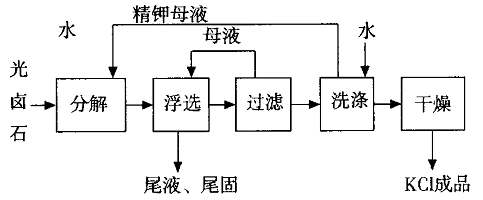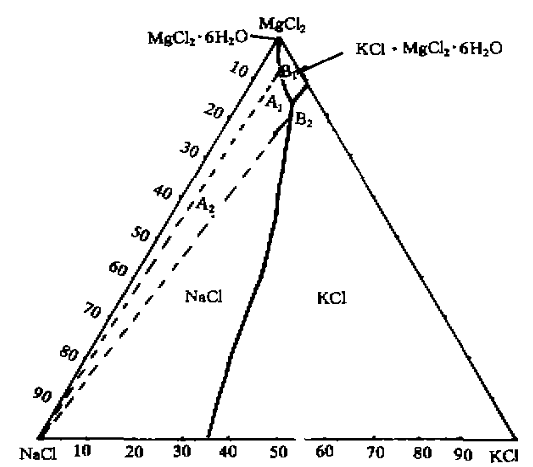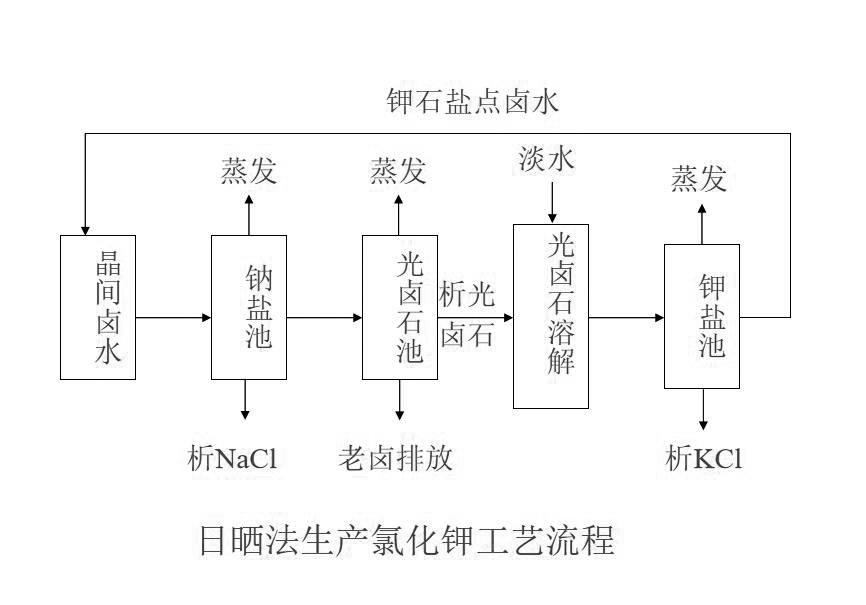Below, Huai 'an potassium salt manufacturer introduces the main production technology of liquid potassium salt mine, and let's have a look!
The main production processes of liquid potash ore include cold decomposition-washing method, cold decomposition-flotation method, reverse flotation-cold crystallization method, insolation method, cold crystallization-positive flotation method, bittern blending method, etc.
(1) cold decomposition-washing process
This process is a relatively primitive process for extracting potassium chloride from dead sea water, which was developed by Israel in the 30' s of the 20th century. It mainly makes use of the stable balance of the liquid phase composition change of seawater during insolation, so that it is easy to control the types and grades of salts precipitated in different salt precipitation stages, and discards the high-sodium carnallite in the just precipitation stage, leaving behind the carnallite precipitated in the later stage, thus obtaining the raw material for preparing potassium chloride-low-sodium carnallite. The main process flow is that seawater is insolated in salt fields to obtain low-sodium carnallite, and then the carnallite is decomposed with water, and then the finished product potassium chloride is obtained through separation, washing and drying procedures.
Cold decomposition-washing process is simple, but the utilization rate of potassium is extremely low. The high-sodium carnallite obtained from salt fields is abandoned, resulting in waste of resources. This process has been eliminated.
(2) Cold decomposition-flotation process
This process was developed by Israel in 1950s, and Dead Sea Engineering Co., Ltd., established in 1953, adopted this process to build a potassium chloride plant with an annual output of 200kt. The cold decomposition-flotation process (developed by Qinghai Salt Lake Research Institute, Chinese Academy of Sciences) adopted by Qinghai Salt Lake Group in 1960s is basically similar to the process originally developed by Israel.
In the process of decomposition, magnesium chloride and a small amount of sodium chloride are also dissolved in water, and the solid phase after decomposition is mainly the mixed salt of potassium chloride and sodium chloride. After flotation, the concentrate contains 70-80% potassium chloride. After countercurrent washing, sodium chloride and magnesium chloride are removed, and the purity of potassium chloride in the dried product can reach 95%. The main process of producing potassium chloride by cold decomposition-flotation in Israel is that seawater is insolated in salt fields to obtain carnallite. After the carnallite is completely decomposed by water, octadecylamine hydrochloride is added for flotation. The solid phase after flotation is washed with water and dried to obtain finished potassium chloride. The cold decomposition-flotation process in China is shown in Figure 2.

图 2 :中国冷分解—浮选法生产氯化钾工艺流程图
Production of potassium chloride by cold decomposition-flotation process saves energy, has less investment in plant construction, and is simple and easy to master. However, the product has fine granularity, poor physical properties and low potassium yield, which is generally 50% ~ 60%. Due to the poor physical properties of the products, the particle size larger than 100 meshes only accounts for 10% ~ 20%, which can no longer meet the requirements of the international market. Therefore, this method is gradually being eliminated. However, due to its stable process and simple process, many manufacturers in Chaerhan area of Qinghai Province in China have adopted this method.
(3) Reverse flotation-cold crystallization process
This process was developed by Israel Dead Sea Engineering Company in 1979. Compared with the cold decomposition-flotation method and the cold decomposition-hot solution crystallization method, this process can significantly save energy. All processes except drying are carried out at room temperature, which is the best process for preparing potassium chloride from carnallite at present. Among them, the technological processes in Jordan and Israel mainly include screening after harvesting in Dead Sea salt fields, cold crystallization of coarse carnallite directly, cold crystallization of fine carnallite after reverse flotation concentration and dehydration, screening after cold crystallization, concentration and dehydration, washing and dehydration, drying, and screening to obtain coarse and fine potassium chloride products.

图3-我国反浮法-冷结晶工艺生产氯化钾工艺流程图
The quality of potassium chloride produced by reverse flotation-cold crystallization process is high, which can reach about 95%, and the product has coarse particle size and good appearance effect However, its process is complicated and difficult to operate (especially the crystallization system), and it has high requirements for raw ore and strong dependence.
(4) solarization process
The main flow of the process is that brine is extracted and evaporated in a sodium salt pond to separate out NaC1, and when the brine is concentrated to carnallite point, it is sent to the carnallite pond for continuous evaporation to separate out carnallite and discharge old brine; Then add fresh water to dissolve it, and discharge it into potassium salt pool for solar evaporation. According to the precipitation sequence of salts, KC1 is first precipitated in the potassium salt pond. When the brine in the potassium salt pond is concentrated until NaC1 is saturated, this brine is called potash salt brine, which is returned to the sodium salt pond for recycling. The particle size of potassium chloride is generally above 0.2 mm The route of concentration crystallization is: firstly, sodium chloride (NaCl) is crystallized; Secondly, crystallizing carnallite (KCl MgCl2 6H2O); At last, crystal water bischofite (MgCl2·6H2O) is crystallized, so the method of extracting potassium chloride products from this type of brine can be determined as follows: firstly, extract the intercrystalline brine, evaporate and precipitate sodium chloride in the sodium salt pond, then discharge the brine into the carnallite pond to continue evaporation, precipitate carnallite, discharge the old brine (mainly containing MgCl2), then add fresh water for dissolution, and discharge it into the potassium salt pond for solar evaporation.
According to the precipitation sequence of salts, potassium chloride is first precipitated in the potassium salt pond. When the brine in the potassium salt pond is concentrated until the sodium chloride is saturated, the brine is called potassium salt brine, which is returned to the sodium salt pond for recycling. The precipitated potassium chloride has a particle size of > 0.2mm, and the mother liquor can be naturally drained by stacking.

图 Na+、K+、Mg++//Cl-——H2O四元水盐体系(25℃) 相图
日晒法生产氯化钾工艺流程
Solar technology makes full use of solar energy, without adding any chemicals, and the products have good quality and high purity, but are greatly influenced by natural conditions.

(5) Cold crystallization-direct flotation process
This process is a new technology developed recently, which controls the supersaturation of carnallite decomposition system to achieve the purpose of growing potassium chloride crystal particles at normal temperature. The main process flow is as follows: carnallite raw materials enter a cold crystallizer and decompose in it, and then potassium chloride crystals with larger particles are crystallized. After the fine crystals discharged from the settling area are washed and dissolved, the mother liquor returns to the crystallizer as decomposition liquid, and the coarse particles are crude potassium. The crude potassium enter a flotation system, and that flotation concentrate is washed with fresh wat, filtered and dried to obtain a finished product of potassium chloride. The average particle size is 0.273 mm, the purity is about 95%, and the recovery rate is about 65%.
Although the process of cold crystallization-direct flotation is simple and the quality and yield of potassium chloride are high, the process is still immature and imperfect.
(6) bittern blending-rapid controlled crystallization process (green potassium 4# process)
This process was invented by Lianyungang Design Institute of Ministry of Chemical Industry of China in 1990s, and reached the international level of potassium chloride production process. This process represents that the production of potassium chloride from carnallite in China has reached the technical level with independent intellectual property rights.

The halogen-adding-one-speed controlled crystallization method has obvious advantages such as simple process flow, excellent product quality, low capital construction investment, low production cost, high operation recovery rate, high resource utilization rate and no environmental pollution, and has broad prospects. However, the process uses decomposed mother liquor as raw material, so chemical raw material manufacturers suggest that it cannot expand its production scale at will.